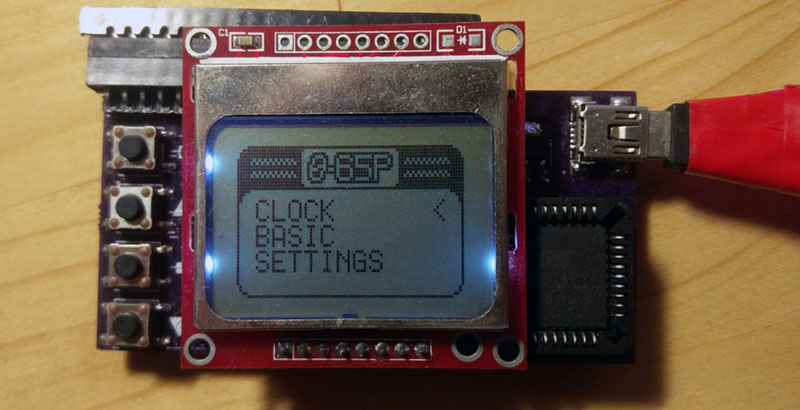We are very familiar with retrocomputers, and if you want you too can build a computer that could have been made in the late ’70s on a breadboard. Just grab your CPU of choice, add some RAM, some ROM, a ton of jumper wires, and give it some way to talk to the outside world. The problem with the computers inspired by yesteryear is that they all, inexplicably, use through-hole parts. If only someone used the small QFP parts instead of the big chonkin’ PDIPs, we could have really small retrocomputers. That’s exactly what [NotArtyom] did, and he managed to come up with a wearable 6502 watch.
The system design for this 6502-based watch is fairly standard for what you would find in any other retrocomputer. There’s a PLCC 6502, 32k of SRAM, 16k of ROM, and a PLLC’d 6522 for a bit of IO. There are a few peripherals hanging off the 6522, and since this thing is a watch the most important is a real time clock. There’s also a Nokia LCD and a 20-pin Commodore keyboard connector.
Software-wise, most of the ROM is dedicated to G’Mon, a generic monitor that can view and modify memory. There’s also EhBasic, and a kernel to handle the RTC, keyboard, and display.
Whether or not this is a useful smartwatch isn’t the question; this is one of the first retrocomputer projects we’ve seen that lean into the non-PDIP versions of these classic chips. This is a bit surprising, because you can still buy these parts, PDIP or not, new from the usual vendors. If nothing else, it’s a demonstration of what can be done with modern IC packages.















If I remember correctly, some of the cheap keychain digital photo frames ran on a 6502-based chip for some reason.
Tamagotchis had a 6502 as well.
Quite a few toys are still 6502s. Most of my day job work is based on 6502s. :)
Wow, 6502’s to the rescue!
Interesting! What line of work do you work for?
I work for a company that does toy invention/design work. We do a lot of work for the various toy companies(We have active products with Moose and Spinmaster, and we do work with Hasbro/Mattel fairly often, too), but our name’s only really “prominent” on one particular line of toys.
I’m one of our three programmers, and we mostly work with 6502-based microcontrollers, because they’re generally all we can afford. We stretch 8MHz and 256 bytes of RAM to the very limits. :)
I wonder if Furby is still 6502 (I doubt it). I write 6502 retro games for a hobby and am still tempted by a 6502 job.
Some are, some aren’t. The Furby Connect looks like it might not be(I can find references to GeneralPlus, which is a chip vendor that I’m quite familiar with, and it being able to download large amounts of content from the associated app lead me to believe it’s one of their 16-bit offerings), but anything prior to that probably is a 6502, as there wasn’t a whole lot of “content” to be downloaded/managed.
Generally, if it doesn’t need to be recording/playing back audio, or downloading/uploading data to a phone, it’s probably either a 6502, or some 4-bit thing if it’s a /very/ simple thing. 16-bit is generally being phased out, as ARM Cortex M0’s are getting down into the same price range, and you get quite a bit more bang for your buck with an M0.
If you’re really curious about what 6502-based processors are still in use, the GeneralPlus GPC3 ( http://www.generalplus.com/1LVlangLN435SVpdv_noSNproduct_detail ) is our workhorse, and the GeneralPlus GPCDxT is it’s up-and-coming successor ( http://www.generalplus.com/1LVlangLN4686SVpdv_noSNproduct_detail ). Neither of those will run an LCD, but they have other chips in their lineup that can, some of which do still have a 6502 as their brain.
What an overkill. An (enormous) bunch of TTL chips would also do!
I’ve not once ever wanted a smart watch, but I want this one.
I’m a fan of the 6502, but doesn’t it require the better part of an amp to run?
Maybe the original NMOS version did, but the newer CMOS versions consume “0.15 and 1.5 mA per MHz at 1.89 V and 5.25 V respectively”, according to wikipedia.
https://en.wikipedia.org/wiki/WDC_65C02